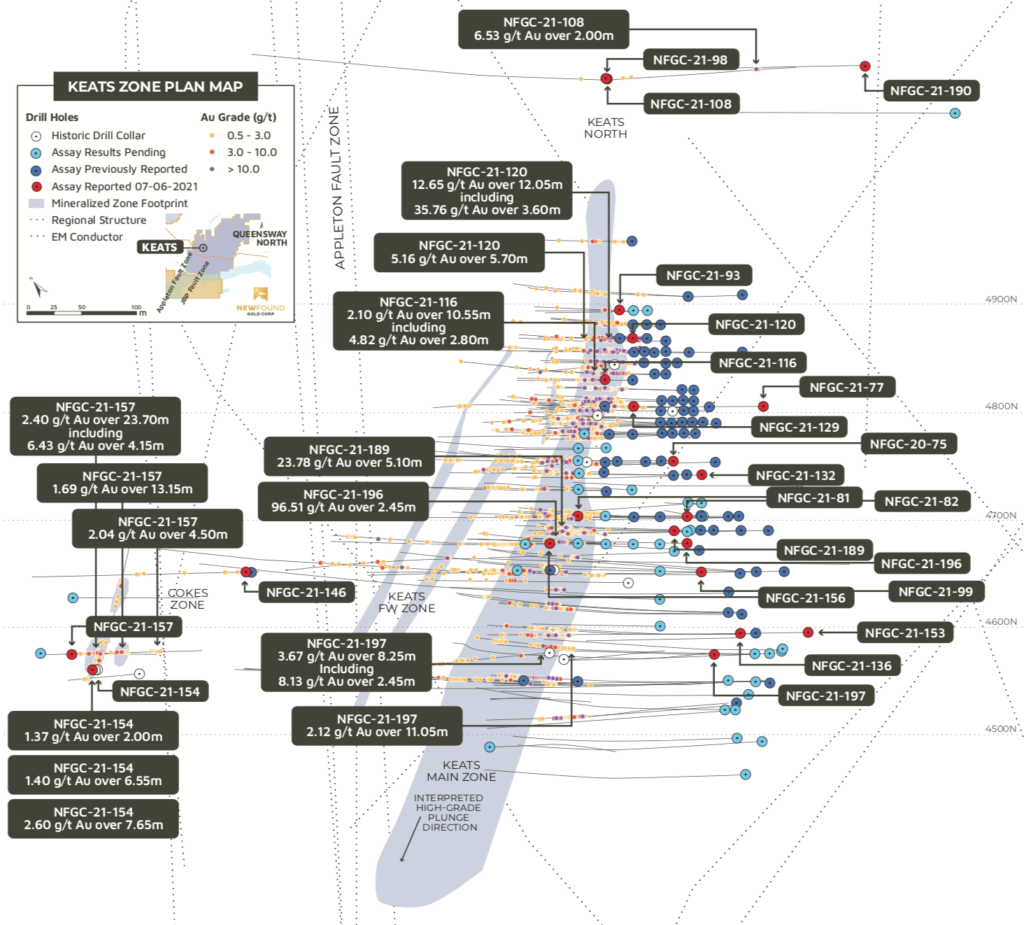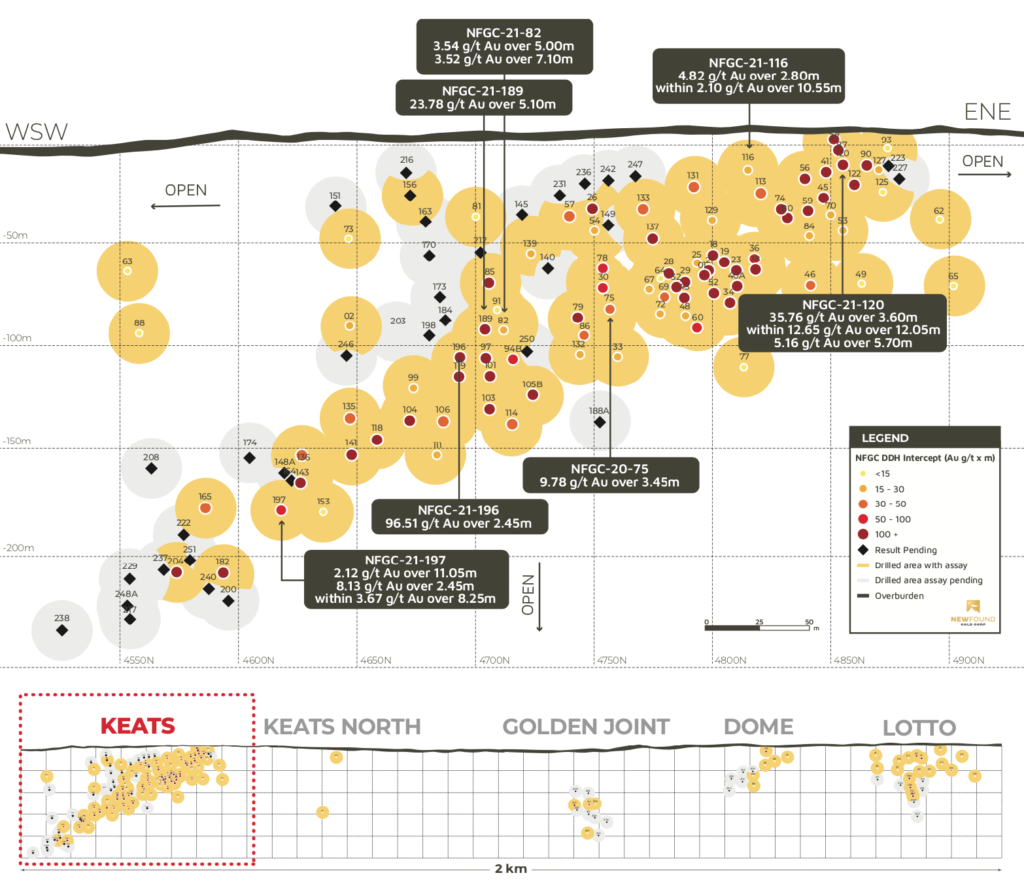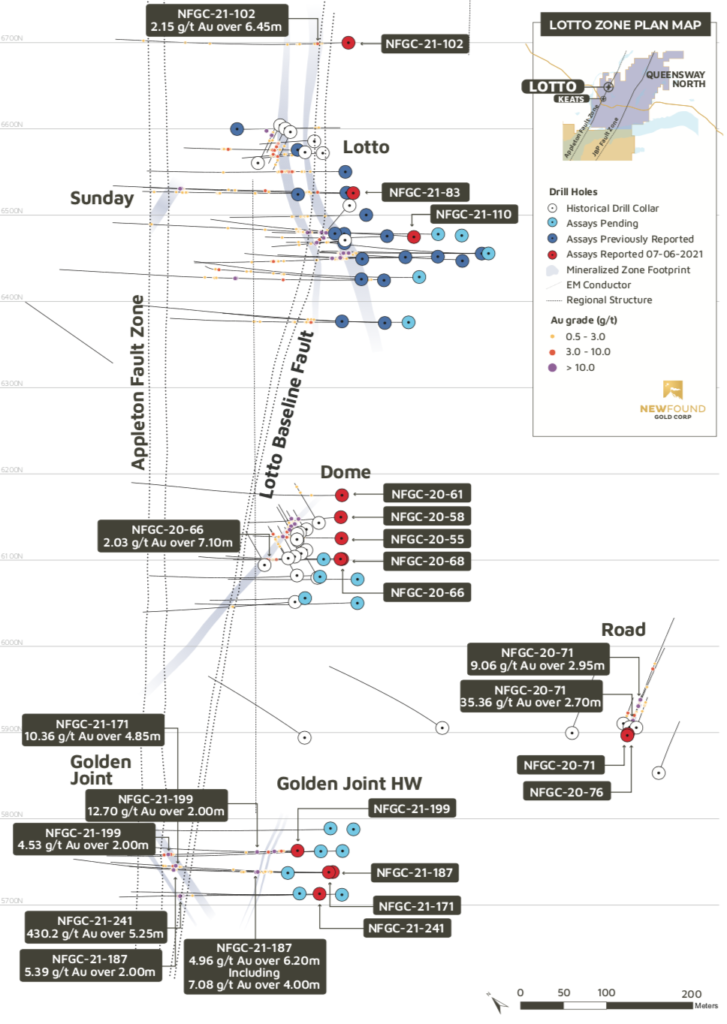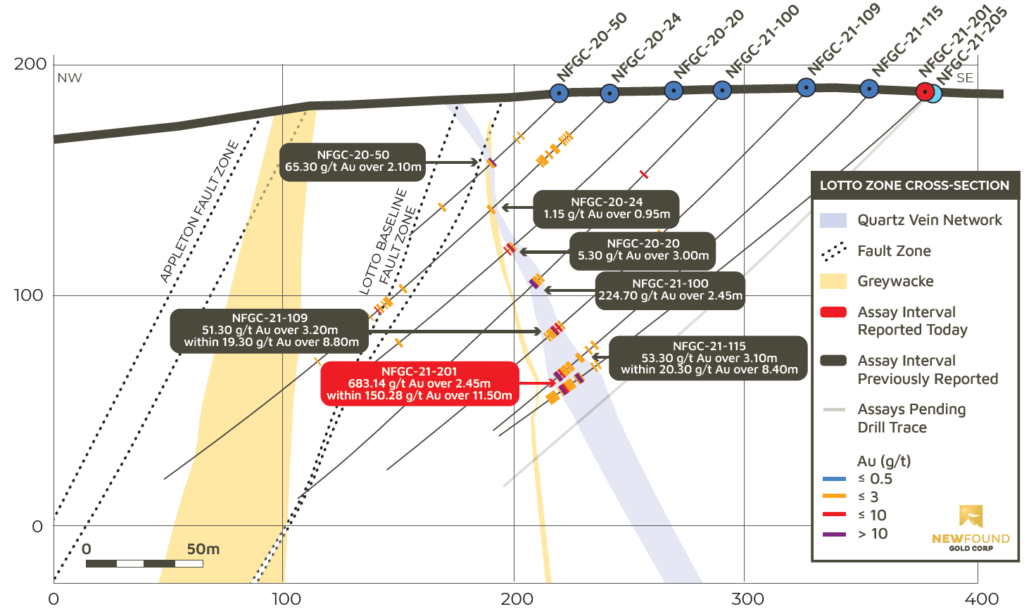New Found (NFG.V): Provides Appleton Fault Zone Exploration Update
Queensway is host to an extensive epizonal orogenic gold system, one capable of generating very high-grade gold mineralization. To date, New Found has discovered three robust structurally controlled high-grade gold deposits: Keats, Lotto and Golden Joint. High-grade gold mineralization is typically comprised of intense quartz stockwork veining with abundant fine particles of visible gold. Although sulphide contents of such mineralization are generally very low, particles of the lead-antimony sulfosalt, boulangerite, occur ubiquitously with native gold. Lower grade gold intercepts are often encountered in the vicinity of such high-grade mineralization often occurring in altered sedimentary host rocks adjacent to quartz veins along with moderately abundant disseminated sulphides including pyrite and arsenopyrite. When such low-grade mineralization is encountered in drilling, it can help point to high-grade mineralization nearby.
New Found, with the help of GoldSpot Discoveries Corp, continually refines its geologic model to maximize the chances of making further high-grade discoveries along the AFZ. Numerous new targets have been the subject of recent drilling, and the Company believes additional high-grade discoveries will be made as it advances its ongoing 200,000m diamond drill program. This news release provides a comprehensive overview of recent exploration results from the AFZ corridor within the North Queensway Project.
AFZ Exploration Highlights
New Found has made significant progress advancing multiple targets along the Appleton Fault Zone on Queensway North. Figure 1 below shows the Keats, Lotto and Golden Joint discovery areas along with additional primary generative targets.
The high-grade discoveries at the Keats, Lotto and Golden Joint zones have each been made by following up on lower grade intervals of gold mineralization from initial drilling in the target area. In addition to the presence of gold mineralization these discovery areas also display areas of alteration and pathfinder elements that appear to be associated with high-grade epizonal style gold mineralization. Significant areas of white mica alteration along with boulangerite and chalcopyrite mineralization occur proximate to higher grade gold.
The generative targets being pursued typically have significant presence of these styles of alteration and pathfinder elements coincident with significant gold mineralization. Based on our interpretation, we believe these areas have a significantly enhanced probability of hosting high-grade epizonal mineralization.
Highlights of initial drilling on these generative targets is summarized the Tables below, additional drill results from this work provided in Drillhole Details section.

Denis Laviolette, President of New Found, stated: “Our understanding of the genesis of high-grade gold mineralization along the Appleton fault continues to evolve. Following up on intervals of lower grade gold mineralization associated with specific styles of alteration and pathfinder minerals and elements was a key step in our discoveries of high grade at Keats, Lotto and recently Golden Joint. There are now more than 15 additional areas along the Appleton fault that have returned significant gold mineralization that we believe are prospective for high grade epizonal style discovery. We are continuing with interpretation work and additional drilling in the pursuit of finding additional zones of high-grade epizonal style gold along 7.8km of strike along the Appleton Fault Zone.
The Appleton fault is a deep crustal structure and plumbing conduit persists for over 7km of strike distance through Queensway North. With our discovery success and continued generation and advancement of new targets, our confidence continues to build that with further drilling we will make additional discoveries of high-grade epizonal gold mineralization along the Appleton Fault Zone.”
Keats to Lotto Corridor
New Found’s three advancing high-grade epizonal discoveries to date occur along an approximately 2km corridor of the Appleton Fault Zone, shown in the long-section in Figure 2 below.

In addition to the Keats, Lotto and Golden Joint discoveries, exploration is continuing on multiple additional target areas across an approximately 800m wide corridor on the east side of the Appleton fault that demonstrate significant gold mineralization coincident with alteration and mineralization styles that are commonly found proximate to high-grade epizonal style mineralization. The generative target areas in this corridor include Keats North, Dome, Road, Golden Joint HW, and Sunday (see Figure 1). Notable drill intervals in these generative targets on the east side of the Appleton include 6.53g/t over 2.00m at Keats North, approximately 200m north of where the main Keats high-grade zone appears to subcrop, 35.4g/t over 2.7m at Road, 38.7g/t over 2.95m at Sunday, and 12.7g/t over 2.0m at Golden Joint HW.
Generative targets along an approximately 500m wide corridor on the west side of the Appleton Fault include Cokes and Little-Powerline which have both returned encouraging drill intervals, as well as Trench 26 and Zone 36 where significant gold mineralization, alteration, and indicator minerals have been noted in trenching to be followed up shortly with drilling.
Keats Area (Keats Main, Keats FW, Keats North, Cokes)
Recently received Keats drill intervals along with intervals returned from Keats North and Cokes are shown on the plan map and long section in Figures 3 and 4 below.

*Note that the host structures along the Appleton Fault Zone are generally interpreted to be steeply dipping and true widths are estimated to be 85% to 95% of reported widths at Keats, 80% to 90% at Lotto, 70% to 90% at Golden Joint, 65% to 75% at Dome, unknown at Cokes, 85% to 95% at Road, unknown at Little-Powerline, and unknown at Knob. Intervals are calculated at a 1 g/t Au cut-off grade; grades have not been capped in the averaging.

*Note that the host structures along the Appleton Fault Zone are generally interpreted to be steeply dipping and true widths are estimated to be 85% to 95% of reported widths at Keats, 80% to 90% at Lotto, 70% to 90% at Golden Joint, 65% to 75% at Dome, unknown at Cokes, 85% to 95% at Road, unknown at Little-Powerline, and unknown at Knob. Intervals are calculated at a 1 g/t Au cut-off grade; grades have not been capped in the averaging.
Keats Main
Highlight intervals from recently received Keats drilling include:
The intervals of 96.5g/t Au over 2.45m in hole NFGC-21-196 and 23.8g/t Au over 5.10m in NFGC-21-189 occur above the primary dilative corridor of the Keats fault zone which still yields significant gold mineralization.
Keats North
Drill holes NFGC-21-98 and NFGC-21-108 were drilled on a fence line approximately 200m north of the main Keats discovery (see Figure 3). Highlight intervals include:
The Company believes that Hole NFGC-21-108 intersected the primary Keats baseline fault structure. Additional drilling is planned to further test the structure in this area.
Cokes
The Cokes target is on the west side of the Appleton fault approximately 300m from the main Keats Zone, which is being drilled on the east side of the Appleton fault. Highlight intervals include:
Notable in the drilling at the Cokes target is a pervasive alteration sequence, several brittle and ductile structural elements and higher sulphide content representing a different style of mineralization from the Keats but suggestive that a robust mineral system has developed on the west side of the Appleton Fault.
Golden Joint to Lotto Corridor
Target locations and recent results the from Golden Joint to Lotto corridor are summarized in Figure 5 below

**Note that the host structures along the Appleton Fault Zone are generally interpreted to be steeply dipping and true widths are estimated to be 85% to 95% of reported widths at Keats, 80% to 90% at Lotto, 70% to 90% at Golden Joint, 65% to 75% at Dome, unknown at Cokes, 85% to 95% at Road, unknown at Little-Powerline, and unknown at Knob. Intervals are calculated at a 1 g/t Au cut-off grade; grades have not been capped in the averaging.
Golden Joint & Golden Joint HW
New Found recently reported results from the Golden Joint discovery with the following highlights (see New Found’s June 29, 2021, news release):
- The high-grade discovery interval of 430.2g/t Au over 5.25m was intersected within a newly discovered gold zone along the hanging wall of the Appleton Fault.
- Based on the recent drilling, New Found’s current interpretation is that the Lotto Baseline Fault extends approximately 1km from the Lotto area to the Golden Joint area (see Figure 5). The vein systems in the Golden Joint appear to occur near the confluence (“joint”) of the Lotto Baseline and Appleton Faults, but controls on the high-grade gold mineralization at Golden Joint are currently unclear.
Results from the parallel Golden Joint hanging wall zone have also included several significant intervals with highlights including:
Road
Highlight results from holes drilled into the Road target are summarized below.
- The Road target is exposed at surface and is the furthest east of the Appleton fault where significant gold mineralization has been found to date but may be related to extensions of the Lotto zone 550m to the northwest.
- Drill hole NFGC-20-71 returned three mineralized vein zones with results including 35.4g/t Au over 2.70m and 9.1g/t Au over 2.95m
- The presence of quartz breccia veins in a separate NW trending fault corridor are suggestive of a similar style of emplacement and mineralogy to the nearby Keats and Lotto zones
Dome
Highlight results from Dome are summarized below.
- Further drilling is being planned at Dome to follow up on these results, again targeting higher-grade epizonal style gold mineralization.
Lotto and Sunday
New Found recently reported results from the Lotto discovery with the following highlights (see New Found’s June 23, 2021, news release):
- The interval 683.1g/t Au over 2.45m within 150.3 g/t Au over 11.5m in NFGC-21-201 is the best result to date from the main Lotto discovery and step-out drilling from this interval is now underway (see Figure 6).
- The high-grade intervals reported to date occur in an interpreted north-south striking vein set, one of a network of multiple secondary north-south striking vein sets interpreted to date over a 300m x 200m area and open and open in all directions.
- The Company continues to test multiple additional targets at Lotto outside of the initial vein target, including follow up drilling on the Sunday Zone interval of 38.7g/t over 2.95m interpreted to be located in the hanging wall of the main Appleton Fault.

*Note that the host structures along the Appleton Fault Zone are generally interpreted to be steeply dipping and true widths are estimated to be 85% to 95% of reported widths at Keats, 80% to 90% at Lotto, 70% to 90% at Golden Joint, 65% to 75% at Dome, unknown at Cokes, 85% to 95% at Road, unknown at Little-Powerline, and unknown at Knob. Intervals are calculated at a 1 g/t Au cut-off grade; grades have not been capped in the averaging.
Other Appleton Fault Zone Target Areas
Zone 36
- Surface trenching in 2020 along an area of high Au soil values resulted in the discovery of Zone 36, approximately 700m north of Lotto on the west side of the Appleton Fault (see Figure 7 below).
- Zone 36 is represented by two parallel northwest trending veins and a third more prominent sub-parallel vein system showing areas of brecciation and was exposed along surface for 140m along strike.
- The presence of vuggy quartz, antimony sulphosalts and visible gold is suggestive that it has a similar epizonal style of mineralization to the Keats and Lotto zones.
- Limited surface sampling of the zone resulted in grab samples up to 47.0 g/t Au and channel samples up to 18.9g/t Au over 1.0m.
- Initial drilling of this target is planned for 2021.

Knob and Grouse
The Knob area was the subject of significant historic drilling by Noranda. Due to winter conditions to date the Company has been unable to safely reach drill pad locations to target the focus of the historic Noranda drilling. Drilling to date by New Found has been peripheral to this target area and has tested for extensions of the historically drilled mineralization, as well as testing additional target zones. Highlight of drill results to date include:
- The Knob and Grouse zones are stratigraphically controlled to a coarse greywacke/conglomerate unit and the company successfully extended the known extents of this unit along strike intersecting visible gold mineralization in several holes including NFGC-21-159 which intercepted 8.78g/t Au over 2.0m, 200m south of the Knob zone within the coarse-grained unit.
- Further surface exploration is planned for the 2021 field season to better refine the geology of this region with the goal of generating new drill targets as significant potential exists.
Drillhole Details
Keats Main and Keats FW
Keats North
Cokes
Lotto
Dome
Road
Knob
200,000m Drill Campaign Update
A total of 267 holes totaling approximately 61,700 meters of drilling has been completed to date, representing approximately 31% of the planned 200,000m program. Results for 150 holes totaling approximately 34,200m have been received and reported to date. Eight rigs are currently turning, with a ninth on site and tenth to arrive by Q3 2021.
NYSE American Listing Update
New Found has been cleared to apply to list its common shares on the NYSE American. The Company expects to commence trading on the NYSE American in early Q3 2021 upon receipt of final approval from the SEC and the NYSE American.
Sampling, Sub-sampling and Laboratory
Host structures along the Appleton Fault Zone are generally interpreted to be steeply dipping and true widths are estimated to be 85% to 95% of reported widths at Keats, 80% to 90% at Lotto, 70% to 90% at Golden Joint, 65% to 75% at Dome, unknown at Cokes, 85% to 95% at Road, unknown at Little-Powerline, and unknown at Knob. In some areas infill veining in secondary structures with multiple orientations crosscutting the primary host structures are commonly observed in drill core which could result in additional variability in true width. Assays are uncut, and calculated intervals are reported over a minimum length of 2 meters using a lower cut-off of 1.0 g/t Au. All HQ split core assays reported were obtained by either complete sample metallic screen/fire assay or standard 30-gram fire-assaying with ICP finish at ALS Minerals in Vancouver, British Columbia, or by entire sample screened metallic screen fire assay at Eastern Analytical in Springdale, Newfoundland. The complete sample metallic screen assay method is selected by the geologist when samples contain coarse gold or any samples displaying gold initial fire assay values greater than 1.0 g/t Au. Drill program design, Quality Assurance/Quality Control and interpretation of results is performed by qualified persons employing a Quality Assurance/Quality Control program consistent with National Instrument 43-101 and industry best practices. Standards and blanks are included with every 20 samples for Quality Assurance/Quality Control purposes by the Company as well as the lab. Approximately 5% of sample pulps are sent to secondary laboratories for check assays.
Qualified Person
The technical content disclosed in this press release was reviewed and approved by Greg Matheson, P. Geo., Chief Operating Officer, and a Qualified Person as defined under National Instrument 43-101. Mr. Matheson consents to the publication of this news release dated July 6, 2021, by New Found. Mr. Matheson certifies that this news release fairly and accurately represents the information for which he is responsible.
About New Found Gold Corp.
New Found holds a 100% interest in the Queensway Project, located 15km west of Gander, Newfoundland, and just 18km from Gander International Airport. The project is intersected by the Trans-Canada Highway and has logging roads crosscutting the project, high voltage electric power lines running through the project area, and easy access to a highly skilled workforce. The Company is currently undertaking a 200,000m drill program at Queensway. Eight rigs are currently in operation at Queensway with the drill count planned to increase to ten rigs by Q3 2021. With a current working capital balance of approximately $80 million, New Found is well funded for this program.
Please see the Company’s website at www.newfoundgold.ca and the Company’s SEDAR profile at www.sedar.com.
Acknowledgements
New Found acknowledges the financial support of the Junior Exploration Assistance Program, Department of Natural Resources, Government of Newfoundland and Labrador.
Contact
To contact the Company, please visit the Company’s website, www.newfoundgold.ca and make your request through our investor inquiry form. Our management has a pledge to be in touch with any investor inquiries within 24 hours.
New Found Gold Corp.
Per: “Craig Roberts”
Craig Roberts, P.Eng., Chief Executive Officer
Email: croberts@newfoundgold.ca
Neither the TSX Venture Exchange nor its Regulation Services Provider (as that term is defined in the policies of the TSX Venture Exchange) accepts responsibility for the adequacy or accuracy of this release.
Forward Looking Statement Cautions
This press release contains certain “forward-looking statements” within the meaning of Canadian securities legislation relating to further exploration and drilling on the Company’s Queensway gold project in Newfoundland; interpretation of results of the drilling program and funding of the drilling program; future discoveries of high-grade gold mineralization; the merits of the Queensway project; and the listing of the Company’s common shares on the NYSE American and the timing related thereto. Although the Company believes that such statements are reasonable, it can give no assurance that such expectations will prove to be correct. Forward-looking statements are statements that are not historical facts; they are generally, but not always, identified by the words “expects,” “plans,” “anticipates,” “believes,” “intends,” “estimates,” “projects,” “aims,” “target,” “suggestive,” “probability,” “appear,” “pursuit,” “potential,” “goal,” “objective,” “prospective,” and similar expressions, or that events or conditions “will,” “would,” “may,” “can,” “could” or “should” occur, or are those statements, which, by their nature, refer to future events. The Company cautions that forward-looking statements are based on the beliefs, estimates and opinions of the Company’s management on the date the statements are made, and they involve a number of risks and uncertainties. Consequently, there can be no assurances that such statements will prove to be accurate and actual results and future events could differ materially from those anticipated in such statements. Except to the extent required by applicable securities laws and the policies of the TSX Venture Exchange, the Company undertakes no obligation to update these forward-looking statements if management’s beliefs, estimates or opinions, or other factors, should change. Factors that could cause future results to differ materially from those anticipated in these forward-looking statements include risks associated with possible accidents and other risks associated with mineral exploration operations, the risk that the Company will encounter unanticipated geological factors, the possibility that the Company may not be able to secure permitting and other governmental clearances necessary to carry out the Company’s exploration plans, the risk that the Company will not be able to raise sufficient funds to carry out its business plans, uncertainties related to the listing on the NYSE American, and the risk of political uncertainties and regulatory or legal changes that might interfere with the Company’s business and prospects. The reader is urged to refer to the Company’s Annual Information Form and Management’s discussion and Analysis, publicly available through the Canadian Securities Administrators’ System for Electronic Document Analysis and Retrieval (SEDAR) at www.sedar.com for a more complete discussion of such risk factors and their potential effects.




























